Lochhead on Marketing
025 Category Creation & Category Design: A New Lens On Business
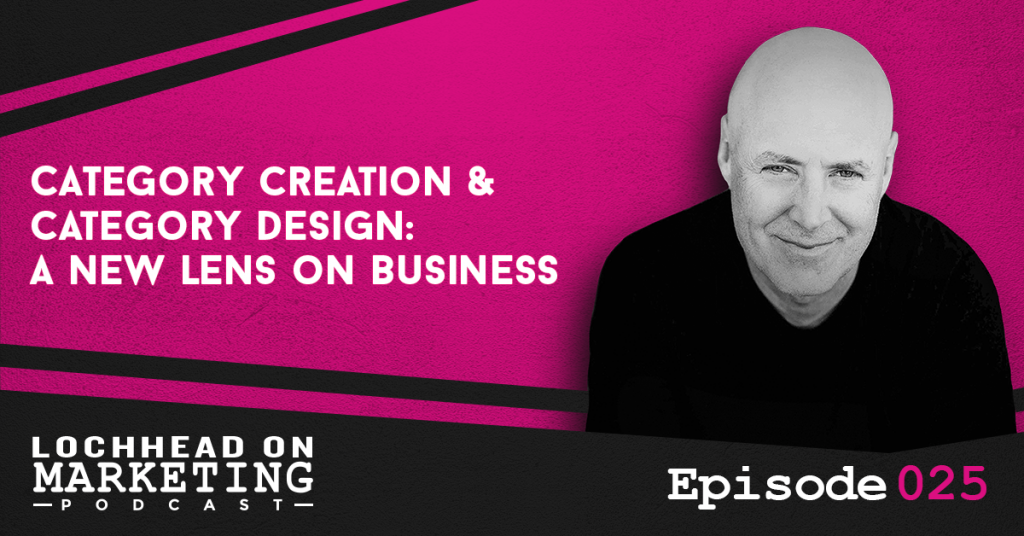
Podcast (lochheadonmarketing): Play in new window | Download (Duration: 19:55 — 27.5MB) | Embed
Subscribe: Apple Podcasts | Spotify | RSS | More
In this episode, Christopher Lochhead takes listeners on an exercise in developing their eye for category creation and category design. Category Design is a new level of thinking in business. It is a whole different approach to marketing and Christopher stresses its importance in building a legendary business.
See Things Differently
Kevin Mainey wrote in the book Play Bigger, that “category design is a new lens on business. Once you have that lens, you see things in a very unique way.” However, listeners often ask Christopher how can they specifically apply these to their businesses.
In this episode, Christopher uses a recent story in the WSJ as an example of how category design is powerful force, that most people don’t know is there. He breaks down a recent story about Google buying FitBit, with the hopes of assisting listeners on how to develop their eyes and ears on category design lens.
Google Buys Fitbit: A Category Design Example
Headline:
Google to Buy Fitbit, Amping Up Wearables Race
By Rob Copeland and Patrick Thomas
Updated Nov. 1, 2019
Sub-head:
Deal to acquire maker of wearable fitness products for $2.1 billion extends Google’s reach in consumer electronics
Wearables is a niche in the consumer electronics mega category.
Google reached a deal to buy wearable fitness products company Fitbit Inc. FIT 15.53% for roughly $2.1 billion, a move that intensifies the battle among technology giants to capture consumers through devices other than smartphones.
Category name before company name, its an example of the fact that people need to know what it is, before knowing who it is. The second sentence is framing the category battle.
For Google, the deal marks a further push into health. as it faces regulatory threats to its massive internet-search and advertising business.
Underscoring Google moving into mega category of health tech, then stating Google’s category king positing in search.
It also puts Google in renewed and direct competition with Silicon Valley neighbor Apple Inc., which in the past week said rising sales of wearables and related services were becoming a bigger driver of its business.
Framing the competition in new wearables category and wearables category growth.
Google’s parent Alphabet Inc. will spend just a sliver of its $121 billion cash hoard to branch out with Fitbit’s products. Alphabet’s $2.1 billion bid was for $7.35 a share in cash, a 19% premium to Fitbit’s closing price Thursday and more than 70% above where the stock was trading last week before deal talks were first reported by Reuters.
Speaks to the premium price category queens get in M&A.
Fitbit shares rose more than 15% to $7.14 on Friday, while Alphabet’s shares ticked up slightly.
The deal lands at a moment when Google and other tech giants are under scrutiny on a number of fronts over their competitive practices and dominance of certain businesses,
“certain businesses” means categories. This points to the domination category queens achieve.
including through acquisitions. But the Mountain View, Calif., company continues to expand aggressively.
Translation: moves into new categories through internal efforts and M&A.
Founded in 2007, Fitbit makes so-called wearables, or watches and bracelets that primarily track health information like heart rate. Such products have fascinated Silicon Valley
Speaks to early adopters embracing the category.
where technology executives of all ages proudly wear rings and other devices to track sleep and “hack” their own personal performance.
Wearables (category name) have proved far less popular with the broader public. Google several years ago launched a brand of smart glasses that attracted as much ridicule as buyers, and Snap Inc. likewise got a lukewarm response to its hyped Spectacles line.
Speaks to the trouble the “wearables” category have had breaking past early adopters to hit a main-stream tipping point. This is normal in the early days of a category. Also note, categories will NOT tip until a category queen emerges. Mainstream buyers want a safe option. AND they do NOT want to compare. They want to buy.
Fitbit traded for $45 soon after it went public in 2015, but the stock has cratered in the past few years as the company ceded market share to Apple and its smartwatch.
Speaks to the category battle with Apple
With its fitness offerings, Fitbit collects myriad and personal data on users that it in turn uses to suggest exercises and other lifestyle changes. And its sale is bound to raise issues around consumer privacy. In announcing the acquisition, Google said it wouldn’t use Fitbit data to help power its massive online advertising business.
Speaks to data as a seminal driver of category flywheels
“Similar to our other products, with wearables, we will be transparent about the data we collect and why,” Rick Osterloh, the head of Google’s hardware division, said in a statement. ”We will never sell personal information to anyone. Fitbit health and wellness data will not be used for Google ads. And we will give Fitbit users the choice to review, move, or delete their data.”
Apple in many ways is a model for what Google hopes to accomplish.
While the Apple Watch was initially a disappointment, sales have picked up lately; and the company’s AirPods were an immediate hit. The iPhone maker said on Wednesday that sales in its wearable business (category name) soared 54% in the latest quarter.
Facebook is also in the wearables mix. This fall the social-media giant reached a deal to buy CTRL-Labs Inc., a startup that develops devices that can interface with the brain.
“We’re talking about data that used to be impossible to collect on a mass scale,” Craig Hallum analyst Alex Fuhrman said. “Only since the beginning of the Fitbit era (new category pioneered by FitBit) have consumers been walking around with wearables that monitor their heart nearly 24 hours a day.”
Google’s hardware line (category) for now consists mostly of slow-selling products like the Chromebook laptop and Pixel smartphone.
Google has spent billions on targets like HTC Corp. , a smartphone maker, and Nest, a home hardware company, with little to show for it in sales, analysts say. Google doesn’t break out financial performance for its hardware division.
It hired Mr. Osterloh, a former Motorola president, in 2016 to steer the nascent unit. In an interview with The Wall Street Journal last month, Mr. Osterloh often referred to the hardware division as a “startup” within the conglomerate.
“I think eventually this will be a very large, important business,” he said.
Some observers remain skeptical. “The acquisition is another example of Google tilting at windmills” in hardware, analysts at Wedbush Securities wrote in a report Friday. “Google is uniformly bad at consumer products in our view, and appears to us to be intent on spending whatever it takes to prove our view wrong.”
Fitbit says it has sold more than 100 million devices world-wide since its founding, and currently has more than 28 million active users.
“Google is an ideal partner to advance our mission” said James Park, a Harvard University dropout who co-founded Fitbit.
Category creators tend to self-identify as mission driven
“With Google’s resources and global platform, Fitbit will be able to accelerate innovation in the wearables category, scale faster, and make health even more accessible to everyone,” he said in a statement.
The deal is expected to close next year, the companies said.
Fitbit’s results have been pressured in recent months. In July, it lowered its full-year revenue outlook after weaker-than-expected sales of its new smartwatch model, Versa Lite.
The smartwatches (sub-category name of wearbles category) are aimed at competing with popular offerings from Apple and Samsung Electronics Co.
Still, the company reported narrower losses in the second quarter as sales of its fitness trackers jumped 51% and the health division showed some strength. Fitbit is scheduled to release its third-quarter earnings report Nov. 6.
—Sarah E. Needleman contributed to this article.
***
So whats the point?
Here’s an article, that most people in business would read as, one company buying another company. In a marketing perspective, it underscores the fact that Google is buying the leading position in a hot new growth category.
“They’re not just buying FitBit or its products or its customers or its technology. They’re buying a position in a category, just like what they did, for example, when they bought Youtube.” – Christopher Lochhead
Christopher hopes that this exercise helped you understand category lens a little bit better.
“I would urge you in your next business discussion and the next arti8cle you read in the Wall Street Journal, or whatever else you read, start to think about these things from a category perspective. How they’re talking about, often is really a description of a larger set of dynamics happening over all in the marketplace.” – Christopher Lochhead
Bio:
Links:
024 The Difference Between a First Mover and a Category Creator w/ Eddie Yoon
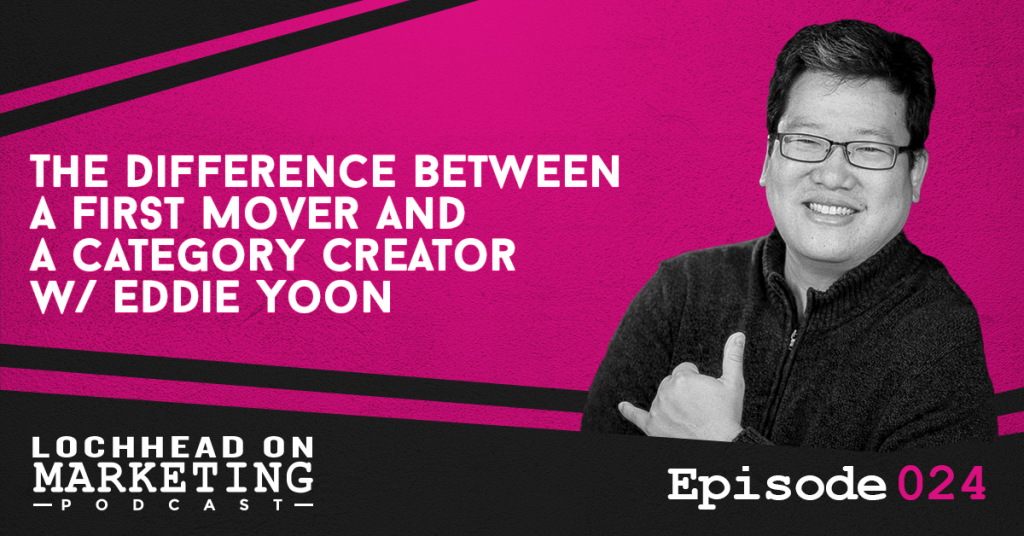
Podcast (lochheadonmarketing): Play in new window | Download (Duration: 36:02 — 49.6MB) | Embed
Subscribe: Apple Podcasts | Spotify | RSS | More
In this episode, Christopher tackles an article that appeared in Harvard Business Review which he co-wrote with Nicolas Cole and special guest for today, Eddie Yoon. Eddie is the author of Super Consumers and is considered a Category Design Guru of Fortune 500.
Today, we will discuss the thinking behind the article, specifically about the power of data flywheel and how high-growth companies used this to stay on top.
Frustration with Misinformation
Eddie discusses the reason behind writing this article with Christopher and Nicolas. Basically, it was sharing the same frustration about companies commensurate misinformation or misunderstanding on becoming the first-mover versus category creators.
“I just think, not only are they being misled, companies are in the relentless pursuit of being first. Let’s think about how to actually build a sustainable advantage at a category queen.” – Eddie Yoon
Furthermore, Eddie shares how he has observed this everywhere and that he is hopeful that people would take that energy that’s been misdirected to “being first”, towards building a flywheel.
Missionary vs. Mercenary
Eddie shares they did tons of analysis which basically asks “what’s your motivation for creating a category, are you a missionary or a mercenary?”
He says that mercenaries see the economics and they try to shortcut what is the fastest way to get to 76% to get the valuation. On the other hand, Missionaries are those who care about the product and the category being screwed up and would work towards improvement.
Eddie further discusses where radical differentiation would come in along with the transformational outcomes. He also says radical generosity is behind this.
Data Flywheel
Eddie shares the study they conducted for the article. Basically, he looked at 10 years worth of Fortune 100`fastest growing company list. He determined if he can identify fast-growing companies between those that were truly category creators. The markers he used were great product, service, company and data flywheel.
“If you are growing in a very specific way, if you have this flywheel, your valuation is meaningfully higher. You have 5x market cap for every dollar in revenue.” – Eddie Yoon
To hear more about The Difference Between a First Mover and a Category Creator and more relevant information from Eddie Yoon, download and listen to the episode.
Bio:
Eddie Yoon is the founder of EddieWouldGrow, LLC, a think tank and advisory firm on growth strategy.
Previously he was one of the senior partners at The Cambridge Group, a strategy consulting firm.
His work over the past two decades has driven over $8 billion dollars of annual incremental revenue.
In particular, 8 of his clients have doubled or tripled in revenue in less than 8 years.
Eddie is one of the world’s leading experts on finding and monetizing superconsumers to grow and create new categories.
He is the author of the book, Superconsumers: A Simple, Speedy and Sustainable Path to Superior Growth (Harvard Business School Press, 2016).
His book was named as one of the Best Business Books of 2017 by Strategy & Business.
He is also the author of over 100 articles, including “Make Your Best Customers Even Better” (Harvard Business Review magazine, March 2014) and “Why It Pays to Be a Category Creator” (Harvard Business Review magazine, March 2013).
Additionally, he has appeared on CNBC and MSNBC.
The Wall Street Journal, The Economist and Forbes has quotes several of his pieces.
Eddie has been a keynote speaker in the U.S., Canada, Kenya, Australia, New Zealand, Denmark, the UK and Japan.
Moreover, Eddie holds an AB in Political Science and Economics from the University of Chicago.
Having been born and raised in Hawaii, he went to the Punahou School in Honolulu.
Eddie lives in Chicago with his wife and three children.
Links:
Harvard Business Review: The Difference Between a First Mover and a Category Creator
We hope you enjoyed this episode of Lochhead on Marketing™! Christopher loves hearing from his listeners. Feel free to email him, connect on Facebook, Twitter, Instagram and subscribe on iTunes! You may also subscribe to his newsletter, The Difference, for some amazing content.
023 Trendjacking Marketing and Public Relations w/ Paul Maher
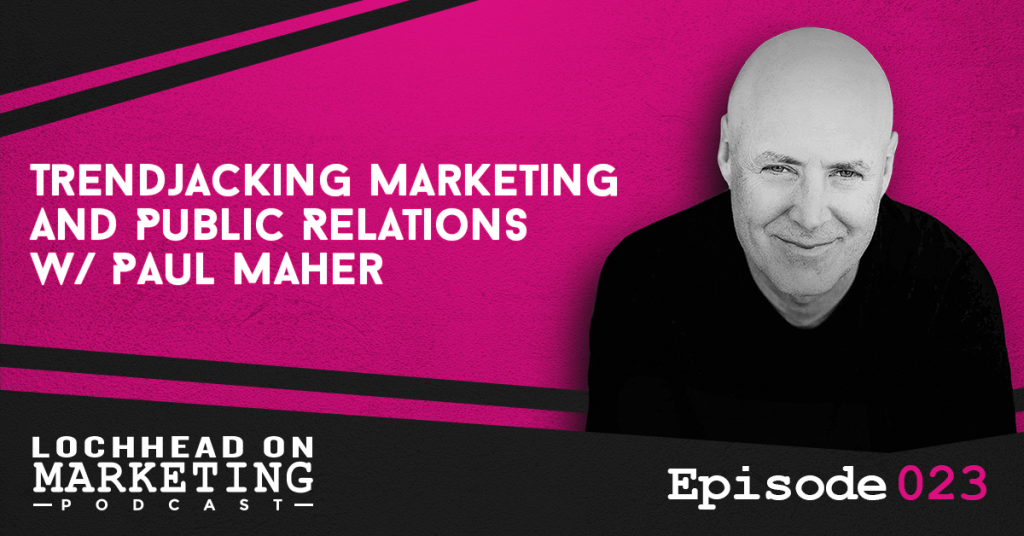
Podcast (lochheadonmarketing): Play in new window | Download (Duration: 27:54 — 38.5MB) | Embed
Subscribe: Apple Podcasts | Spotify | RSS | More
Today is another special episode of Lochhead on Marketing as Paul Maher, Founder of Positive Marketing (UK) joins us to talk about Trendjacking Marketing and Public Relations. His firm, Positive, won the SABRE Award for Best-earned Media Agency in Europe, Middle East, and Africa.Trendjacking
Paul Maher discusses the secret black art of marketing, PR, communications, and media called the trendjacking. This PR strategy is widely used nowadays as marketers aim to position themselves to become consistently relevant to their market.“Trendjacking is all about how do we take what’s happening in the news and attach ourselves to that, use that as an advantage to become an expert, to become known, to position ourselves effectively.” – Paul MaherChristopher and Paul have worked in several projects in the past and have actually the promulgators of trendjacking when they diverted a mergers and acquisition news of a competitor in the past.
Seven Secrets of Trendjacking
1. BE POSITIVE The news happens anyway, why not be in it? Category leaders make rather than observe the news. 2. BE PROVOCATIVE To do this you need to recognize the very definition of news is what you DIDN’T know, or as William Randolph Hearst, the biggest news baron of the pre-Facebook world famously said, ‘WHAT SOMEONE ELSE DOES NOT WANT YOU TO KNOW’. Get creative and find out who does not want to know what you want to say. 3. PREDICT (IT’S CALLED A NEWS CYCLE FOR A REASON) As well as great content, you need great timing. To know when is the optimal time to drop your bomb, you need to read patterns and become a news junkie, not an expert on everything from Celebrity Diets to Robot Brain Surgery, but at least stay across what’s going on in your sector. Preferably twice or more a day. Alternatively hire help, in the form of an agency or consultant who will. 4. PREPARE, PREPARE, PREPARE Set the trap and give yourself options. So perhaps have a set of pitches for each eventuality. England’s new Prime Minister Boris Johnston, also until recently one of the UK’s highest-paid newspaper columnists wrote two versions of an opinion piece, one for and one against Brexit. This way he hedged his bets and prevented a last-minute rewrite, we do this often for clients who want to trendjack major Government data announcements, such as Non-Farm jobs, GDP, etc. This brings us to. 5. BE PROMPT – ONLY EARLY BIRDS CATCH WORMS As a former journalist, dealing with hundreds of inbound calls each day, I would react to the ‘News no one else wants you to hear’ positively the first time. I also understand the second time a fresh angle is pitched, it is just plain old. Many of those who work on flagship news programs start their day earlier than the rest of the world. As the news rolls 24×7 it makes sense to make that early morning call or speak to Planning Departments the night before you drop. 6. BE PRAGMATIC – ORIGINAL BUT READY TO FLEX YOUR ANGLES Ambitious and original trendjackers are luckier trendjackers. Flip your angle, be more counter-intuitive, find the perfect image to accompany your trendjack. Smartest of all, chalk up your failures, wait for the news cycle to roll around and point to a ‘Told you so’ prediction when it does. We regularly issue ‘Open Letters’ to regulators, government bodies or even the entire tech industry when we scratch on a trendjack, just SO WE CAN GO BACK. Predictions are hard, especially in the future. So better to make them early and forget those which don’t come off. 7. BE PERSISTENT Recognize these perennial stories? They are not going away.- Users disappointed by tech outage
- Record good/bad holiday retail sales
- Sales of hot new thing break records
- CEO under pressure from board members
- Employment figure up/down last quarter
Links:
Linkedin UK: Paul Maher Positive Marketing We hope you enjoyed this episode of Lochhead on Marketing™! Christopher loves hearing from his listeners. Feel free to email him, connect on Facebook, Twitter, Instagram and subscribe on iTunes! You may also subscribe to his newsletter, The Difference, for some amazing content.022 Is Your Marketing Better or Different?
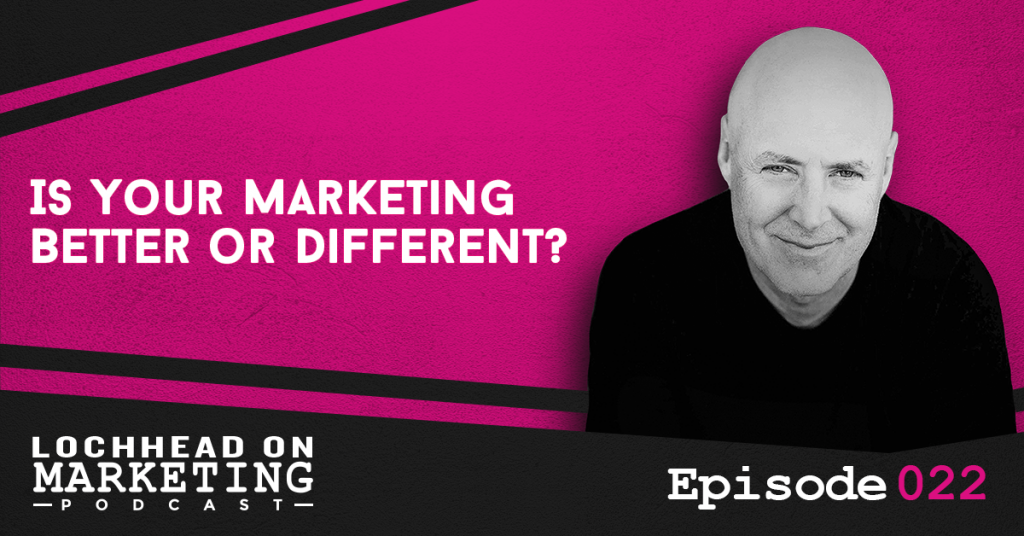
Podcast (lochheadonmarketing): Play in new window | Download (Duration: 7:41 — 7.2MB) | Embed
Subscribe: Apple Podcasts | Spotify | RSS | More
Christopher Lochhead discusses differentiation or differentiators of a brand, product or company. He further shares what legendary marketers do, makes their marketing better or makes it different?Differentiators
We often hear this word a lot in marketing: differentiation. Christopher poses the question when speaking about a product or brand differentiation, is it really different or is it better? In reality, when most CEOs, CMOs, entrepreneurs and product investors say differentiators, what really comes out of their mouth is better. Christopher however, believes making a difference is the better choice.True Differentiation
Christopher suggests a brainstorming session with people in order to determine true differentiation. Create a list of “what makes you different.” Step back and look at your extensive list and tick what makes you different.“If you have a list of 50 differentiators out there, if five of them are truly different, you’ll be doing well, I think.” – Christopher LochheadWhy does this matter? It matters because different forces a choice, and better is a comparison game. Legendary marketers want to own a position where they can’t be easily knocked off. They prefer the perception of being unique, distinct, hard to replace and as someone who solves a problem and creates value.
The “Better” Game
Christopher cites Pepsi as the top contender in this “better” game. They run a series of campaigns comparing themselves to Coke. However, this still proves to be ineffective.“The problem with this better game is, whatever you’re comparing yourself better with, ultimately, is the thing you’re giving power to.” – Christopher LochheadOne of the legendary things that category designers and creators tend to do is to never talk about competitors. Exactly, for this reason, the different conversation, forces a choice. Fundamentally, marketing is about distinguishing oneself.
Bio:
Christopher Lochhead is a Top 25 podcaster and #1 Amazon bestselling co-author of books: Niche Down and Play Bigger. He has been an advisor to over 50 venture-backed startups; a former three-time Silicon Valley public company CMO and an entrepreneur. Furthermore, he has been called “one of the best minds in marketing” by The Marketing Journal, a “Human Exclamation Point” by Fast Company, a “quasar” by NBA legend Bill Walton and “off-putting to some” by The Economist. In addition, he served as a chief marketing officer of software juggernaut Mercury Interactive. Hewlett-Packard acquired the company in 2006, for $4.5 billion. He also co-founded the marketing consulting firm LOCHHEAD; was the founding CMO of Internet consulting firm Scient, and served as head of marketing at the CRM software firm Vantive. We hope you enjoyed this episode of Lochhead on Marketing™! Christopher loves hearing from his listeners. Feel free to email him, connect on Facebook, Twitter, Instagram and subscribe on iTunes! You may also subscribe to his newsletter, The Difference, for some amazing content.021 Is Your Brand Blue?

Podcast (lochheadonmarketing): Play in new window | Download (Duration: 11:05 — 10.2MB) | Embed
Subscribe: Apple Podcasts | Spotify | RSS | More
In today’s episode, Christopher Lochhead dives down deep into the power of colors and how it affects your brand marketing. In a world where almost all brands are Blue (and some are red), how do you make your brand different and stand out?
What’s With Color Blue?
Christopher recently represented a tech company with a stand-out logo, it’s color pink and orange. According to this company, 70% of B2B company logos are blue.
Christopher researched this claim and indeed found out, 33% of the world’s top brands companies are blue. Some 29% are red, 28% are black or grey and 13% are yellow or gold.
“A big part of doing legendary marketing is standing out, being different, being unique. Then for the most part, if you’re gonna be blue, you’re not going to stand out and frankly if you’re gonna be red, you’re probably not gonna stand out, too.” – Christopher Lochhead
Colors and Lack Thereof
One of the guests of Follow Your Different David Rendall, Ph.D., author of Freak Factor, is one unique example. He embraced the color pink. In fact, he wears pink shirts, pink suits and even his eyeglass frames are pink.
As a public speaker, he wears pink not only to stand out but to send a message to the world that its okay to express oneself and let go of what others might think of you. Another example is Max Temkin, the creator of Cards Against Humanity. He shared that he has no eye for color so he just went with black and white, with a distinct font.
“If you think about brands how many brands do you know that actually are strategic in their use of color?” – Christopher Lochhead
An Underexploited Opportunity
Legendary companies and legendary brands stand out because they are different. Color is an underexploited opportunity to stand out. Christopher encourages marketers and designers to think strategically about color.
“If you are involved with the re-brand or brand launch, I would encourage you to take a look at all of the brands in your near-space categories and hold it against the wall and look at what they look like [against your brand]” – Christopher Lochhead.
Christopher further asks, “how can you use color as part of your brand, as part of your logo to stand out? Ultimately, he asks what color or colors can you own? This is a great opportunity to gain a strategic advantage over the competition.
Bio:
Christopher Lochhead is a Top 25 podcaster and #1 Amazon bestselling co-author of books: Niche Down and Play Bigger.
He has been an advisor to over 50 venture-backed startups; a former three-time Silicon Valley public company CMO and an entrepreneur.
Furthermore, he has been called “one of the best minds in marketing” by The Marketing Journal, a “Human Exclamation Point” by Fast Company, a “quasar” by NBA legend Bill Walton and “off-putting to some” by The Economist.
In addition, he served as a chief marketing officer of software juggernaut Mercury Interactive. Hewlett-Packard acquired the company in 2006, for $4.5 billion.
He also co-founded the marketing consulting firm LOCHHEAD; was the founding CMO of Internet consulting firm Scient, and served as head of marketing at the CRM software firm Vantive.
Links:
Follow Your Different – Max Temkin
Follow Your Different – David Rendall
We hope you enjoyed this episode of Lochhead on Marketing™! Christopher loves hearing from his listeners. Feel free to email him, connect on Facebook, Twitter, Instagram and subscribe on iTunes! You may also subscribe to his newsletter, The Difference, for some amazing content.
020 The Power of Podcast Guesting w/Tom Schwab, CEO of Interview Valet
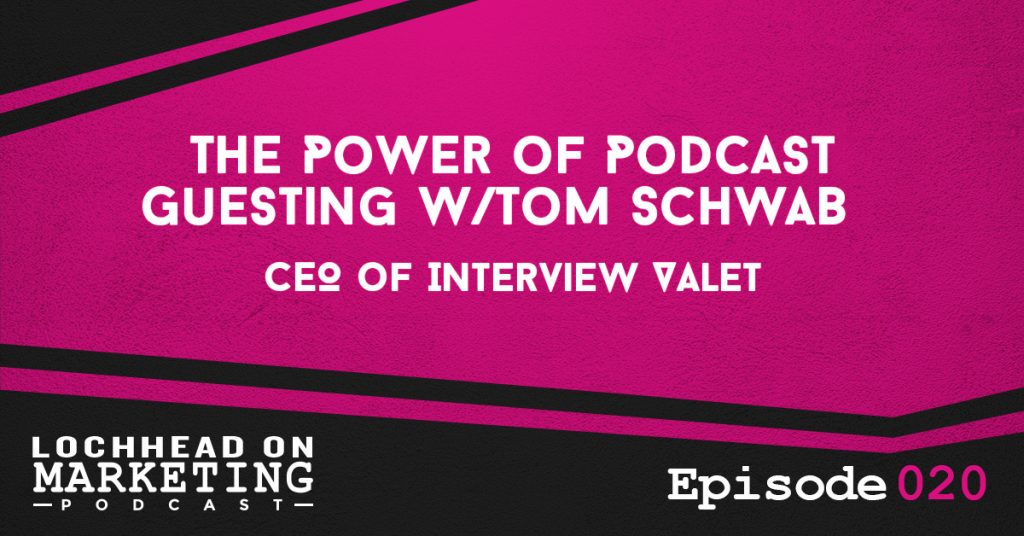
Podcast (lochheadonmarketing): Play in new window | Download (Duration: 46:36 — 42.8MB) | Embed
Subscribe: Apple Podcasts | Spotify | RSS | More
From time to time, we will bring on guests to go deep on a topic in a particular field. Today’s guest is Tom Schwab, founder of Interview Valet. As we celebrate International Podcast Day, we will discuss the power of podcast guesting and why it is a strategic component of legendary marketing today.
Connecting with People
Tom stresses the importance of podcast guesting, especially for business executives, authors, and entrepreneurs. He believes exposure brings opportunity and podcast guesting is one of the most intimate and targeted ways for customers to know somebody.
“I love podcasts because its a way to really connect with people. You’re not yelling, you’re talking with them. They’re choosing to listen to you.” – Tom Schwab
Mainstream Media vs. Podcasting
Tom discusses how powerful podcasting. He says it should be a major part of one’s content strategy. In mainstream media, aside from the cost to advertise (television, print, and radio), one acquires a limited time and limited space, unlike in podcast guesting, where it reaches hundreds of thousands, overtime.
“You’re tapping into an audience, getting that like and trust, getting introduced by someone, they already know. The other thing too is, if you do a live speech, it’s really hard to repurpose that content. If you do a podcast interview, you can do the transcript to make blogs.” – Tom Schwab
Christopher agrees with Tom, as he speaks based on experience. He mentions how he appears on different mainstream media and only get to share a portion of his thoughts for a few seconds.
“Podcast interview is an easy and scalable way to really go deeper. People will understand you and what really drove you, why you got into the business. People should know they could like and trust you. That’s really hard to do in a 30 sec clip or a little Facebook ad.” – Tom Schwab
The Golden Age of Podcasting
Tom cites Harvard University and the conference that they organized last year on podcasting. They call this time as the Golden Age of Podcasting and there is never the best time to explore podcast advertising other than at the present time.
Christopher also shares that there is a lot of whitespace opportunity in podcasting. He believes that there is a high value for sponsors because podcasts provide a high level of intimacy in terms of getting to know the guests through a conversation.
“I think today, brands want to know the heart behind it. Those people that can get out there early and explain that, not in an ad but in an actual conversation. To me, that’s where you can really build up a lifetime value of a customer.” – Tom Schwab
To hear more about the power of podcast guesting and more relevant information from Tom Schwab, download and listen to the episode.
Bio:
Tom Schwab knows how to build an online business.
He’s done it successfully several times and now helps others find online success with podcast interview marketing.
Marketing at its heart is starting a conversation with someone who could be an ideal customer.
Tom helps thought leaders (coaches, authors, speakers, consultants, emerging brands) get featured on leading podcasts their ideal prospects are already listening to. The Interview Valet system then helps them to turn listeners into customers.
The author of Podcast Guest Profits: Grow Your Business with a Targeted Interview Strategy, Tom is also Founder/CEO of Interview Valet, the category king of Podcast Interview Marketing.
Links:
We hope you enjoyed this episode of Lochhead on Marketing™! Christopher loves hearing from his listeners. Feel free to email him, connect on Facebook, Twitter, Instagram and subscribe on iTunes! You may also subscribe to his newsletter, The Difference, for some amazing content.
019 Power of a Point of View: Play Bigger Unplugged
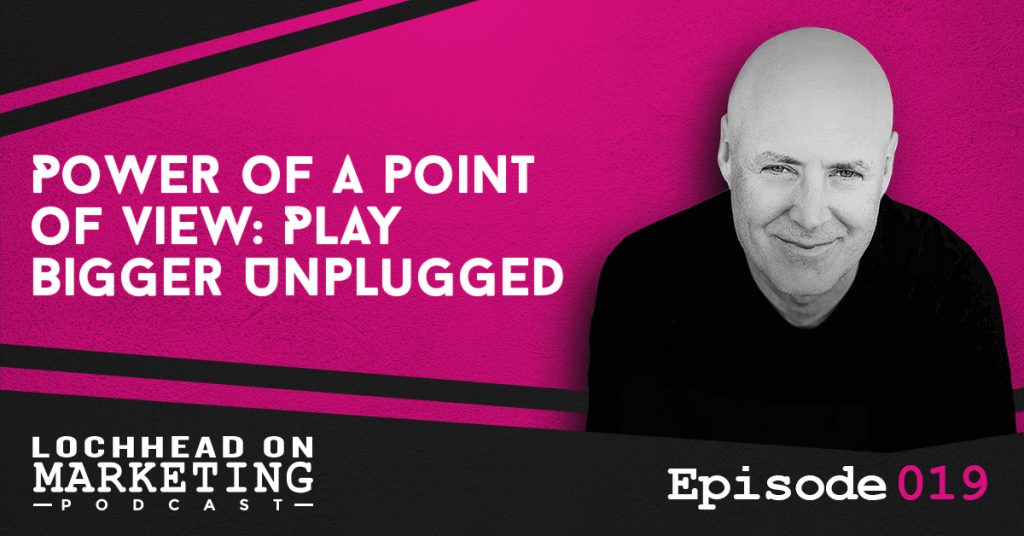
Podcast (lochheadonmarketing): Play in new window | Download (Duration: 15:27 — 14.2MB) | Embed
Subscribe: Apple Podcasts | Spotify | RSS | More
Christopher Lochhead shares an excerpt today from his first book, Play Bigger: How Pirates, Dreamers, and Innovators Create and Dominate Markets about the importance and the power of a point of view. He shares to us why legendary marketers opt to sell a POV, rather than sell a product or service.
Market the POV, not the product!
Legendary creators and designers, market the point of view or POV, not their product and services. When companies show consumers the idea or the problem that they envision to solve, consumers will most likely become interested in the products and services around that idea.
“Its counter-intuitive for most marketers, innovators and CEOs. We think what we’re doing in marketing, is marketing a product with features and maybe, benefits. When in reality, category creators and designers market the POV, because once people subscribe to your way of looking at things, they are going to be interested in what you have to market.” – Christopher Lochhead
POVs are timeless
POV is the company’s true North. It doesn’t change over time, unlike messaging. Companies such as Salesforce or American Airlines have consistently focused on their POV. These are companies who have anchored their business to a point of view, about what they stand for in the world.
Messaging is Tailored POV for an Audience
Christopher cites examples on how messages are tailored POVs for an audience, idea or a trend. He shares how they train an entire company on how to deliver their POV. Employees watch a 10-min presentation on thePOV of the company. The ultimate goal is for the employees to be able to deliver the POV.
Play Bigger Chapter 5
Here is an excerpt from Chapter 5 of the book Play Bigger:
“Stories have always been an industrial-strength force in human progress, from the epic poems of Homer to the tales of Marco Polo, Shakespeare’s historical plays, the novels of Ayn Rand, and biographies of Steve Jobs.
Stories alter perspectives and exert influence.
When traders on Wall Street consider a stock, they often ask, “What’s the story?”
When pitching a venture capitalist, entrepreneurs get funding when they craft a great story, and now a cottage industry offers pitch training.
Raw information reaches us on an intellectual level, but stories reach into our hearts and our pants.
Decades of brain research have demonstrated that stories have a more lasting impact than facts.
One 1969 Stanford study, “Narrative Stories as Mediators for Serial Learning,” showed that students remembered six to seven times more words embedded in a story compared to random words. [i]
In the 2010s, Paul Zak, a professor at Claremont Graduate University found that character-driven, attention-grabbing stories actually increase oxytocin in the brain.
Oxytocin is an empathy chemical, and it motivates cooperation and understanding—quite important when trying to convince someone to, as Apple used to say, think different.
“My experiments show that character-driven stories with emotional content result in a better understanding of the key points a speaker wishes to make and enable better recall of these points weeks later,” Zack wrote.
He added a swipe at the way too much business has been conducted for far too long:
“In terms of making an impact, [storytelling] blows the standard PowerPoint presentation to bits.”[ii]
That’s why category designers tell a story. We call that story a point of view, or POV.
After you come up with an aha of an initial market or technology insight, and after you discover and define the right category, you have to craft the story about the category that you’ll tell. You need a powerful POV.
A POV tells the world you’re a company on a mission, not a missionary company looking to make money any way it can.
It frames the new problem that your category identifies and sets you up as the answer. When someone can articulate your problem, you believe that person must have the solution.
It’s why Bill Clinton won two presidential elections by claiming, “I feel your pain,” and why Ronald Reagan beat Jimmy Carter by simply asking, “Are you better off than you were four years ago?”
Politicians are masters at this.
A great POV separates the companies, products, and categories that people love from the ones they, at best, tolerate.
When you start to think about it, you can easily see the difference between a company that has a strong POV and one that has a POV black hole.
In grocery stores, you can sense that Whole Foods has a clear POV, built around healthy gourmet products, while Safeway seems to have no POV at all other than selling groceries.
Southwest Airlines has a palpable POV; United Airlines does not.
Apple has a POV; Microsoft does not.[iii]
A POV conditions the market to accept and embrace the company’s vision and have the same aha the founders experienced.
The story leads potential customers on their from/to journey, so they understand both what is missing and why your company can fix that problem.
A POV has to shift people’s minds so they reject an old way of thinking and come to believe in something new.
It has to reach people on an emotional level.
No one remembers what you say—but they remember how you made them feel.
That feeling can be excitement about something that’s coming, or fear of missing out.
Some of the best POVs make people think: “Oh fuck, I don’t have one of those! I have to get one of those!”
To reach people’s emotions, a POV has to sound the way people talk.
It has to be simple, direct, visceral. Language matters! (check out episode Don’t Take My Word For It, inspired by Lee Hartley Carter)
Nobody in the history of the human race has ever been moved to joy or tears by a train wreck of lazy business babble.
The story about your business is more important than the facts about your business.
Sound outrageous? Maybe, but the brain research proves it’s true.
People relate to and remember stories—even people who make a living analyzing facts.
A POV tells a story with a beginning, middle, and end.
It tells the world why this category and the company creating it are different.
Different sticks.
Different forces a choice between what was and what can be.
A POV built around better is about comparing your offering to the thing customers already know.
Better reinforces the power of the category king you’re trying to beat (who by definition is not you).
If customers think two companies are tied in the better wars, they just choose the category king—or the lowest price if there’s no clear king.
A great POV takes you outside the better wars and sets you in a different space all your own.
A well-executed POV gives the company identity and culture.
It becomes the invisible hand that guides your priorities.
It results in the right kinds of employees joining the company, the right kinds of investors funding it, and the right ecosystem building out around it—and, by the way, repels those you don’t want hanging around.
Ultimately, the POV steers the company’s strategy.
A powerful POV guides every decision the leadership team makes and every initiative it pursues.
The POV helps employees intuitively feel how they should perform their jobs so they align with the company’s strategy.
Most great, enduring companies have a POV imprinted on their DNA.
To hear more about the power of a point of view and more relevant information from Christopher Lochhead, download and listen to the episode.
Bio:
Christopher Lochhead is a Top 25 podcaster and #1 Amazon bestselling co-author of books: Niche Down and Play Bigger.
He has been an advisor to over 50 venture-backed startups; a former three-time Silicon Valley public company CMO and an entrepreneur.
Furthermore, he has been called “one of the best minds in marketing” by The Marketing Journal, a “Human Exclamation Point” by Fast Company, a “quasar” by NBA legend Bill Walton and “off-putting to some” by The Economist.
In addition, he served as a chief marketing officer of software juggernaut Mercury Interactive. Hewlett-Packard acquired the company in 2006, for $4.5 billion.
He also co-founded the marketing consulting firm LOCHHEAD; was the founding CMO of Internet consulting firm Scient, and served as head of marketing at the CRM software firm Vantive.
Links:
Follow Your Different – Lee Hartley Carter
Lochhead on Marketing: Don’t Take My Word For It
Play Bigger: How Pirates, Dreamers, and Innovators Create and Dominate Markets
[ii] Paul J. Zack, “Why Your Brain Loves Good Storytelling,” Harvard Business Review, October 28, 2014,
[iii] At least it does not in the 2000s. In the 1980s and 1990s, under Bill Gates, Microsoft certainly had a POV. Roughly translated, it was: “A computer on every desk, all of them running Windows, and we’ll bulldoze the fuck out of anyone who gets in our way.” In the 2010s, under a new CEO, Microsoft is again trying to find its voice.
We hope you enjoyed this episode of Lochhead on Marketing™! Christopher loves hearing from his listeners. Feel free to email him, connect on Facebook, Twitter, Instagram and subscribe on iTunes! You may also subscribe to his newsletter, The Difference, for some amazing content.
018 Personal Branding is Bullshit
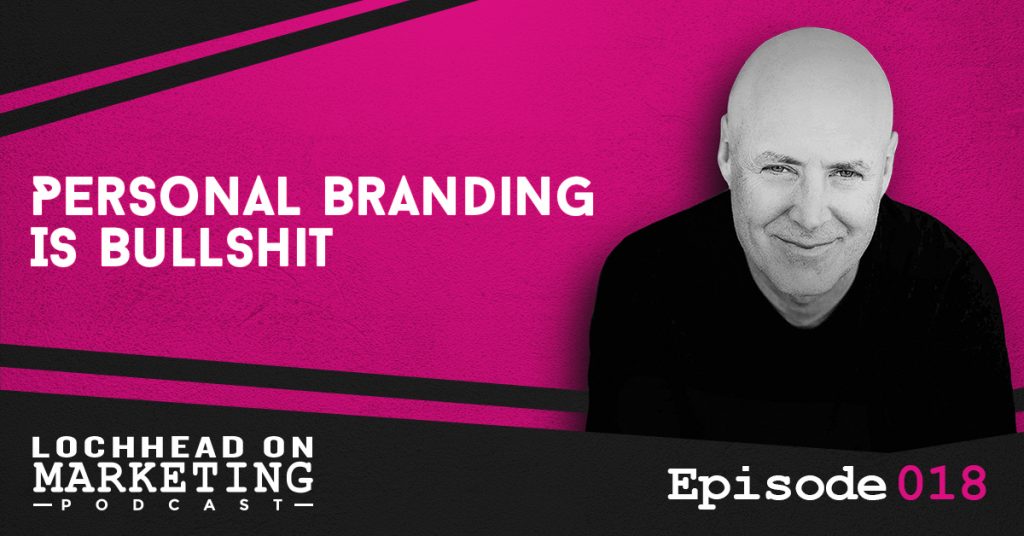
Podcast (lochheadonmarketing): Play in new window | Download (Duration: 10:03 — 9.3MB) | Embed
Subscribe: Apple Podcasts | Spotify | RSS | More
In this episode, Christopher Lochhead talks about a giant topic in business today, personal branding. He further shares the difference between a brand and a person. Moreover, he discusses why legendary executives and marketers don’t give weigh to personal branding much.
Personal Beef with Personal Branding
Personal branding has become a giant issue in business today. It seems like people cannot fire up their social media, such as Linkedin and even Amazon, without personal branding. The idea started around the late 80s or early 90s and has become effed up overtime.
Christopher lays out his argument on the difference between a brand and a person. People have a mental connection with a brand while with a person, people develop relationships.
“I have a very different relationship with my friend Sue Barsamian. She’s the most effective exec I know. Guess how much time she spent thinking about and working on her personal brand? Zero!” – Christopher Lochhead
Developing A Reputation
Sue Barsamian was the guest on Follow Your Different Episode 083. She has a solid 36-years in Silicon Valley, working with Startups and multinationals such as HP. Christopher shares that she has zero efforts in maintaining a personal brand, instead, she aims to develop a reputation.
Silicon Valley respects Sue for producing legendary results and creating massive value. Moreover, she dominated her own niche: “Legendary Enterprise Tech Executive, who scales.” In developing a reputation, Christopher poses the following questions:
“What’s your personal Niche Down? Where are you going to focus your talent? What results are you going to produce? Who are the kinds of people you want to surround yourself with?” – Christopher Lochhead
Rethink this Personal Branding Bullshit
Christopher encourages everyone to re-think this idea of personal branding because he believes that what people prefer is a reputation.
“Reputations come from producing legendary results. Personal branding, by definition, is contrived and inauthentic.” – Christopher Lochhead
People would best be deemed as a person of character, who produces results and is doing legendary work. In conclusion, Christopher advises everyone to spend zero time on personal branding and focus, instead, on the following:
1) Your personal Niche Down – what niche do you want to be known for owning
2) Producing legendary results – people who produce legendary results are highly sought after in business. They are unique by definition and they hang out with people who also do legendary things.
3) and making a difference.
“Because in my experience, people who do that, get the most valuable thing in business: a reputation.” -Christopher Lochhead
To hear more about why personal branding is bullshit and more relevant information from Christopher Lochhead, download and listen to the episode.
Bio:
Christopher Lochhead is a Top 25 podcaster and #1 Amazon bestselling co-author of books: Niche Down and Play Bigger.
He has been an advisor to over 50 venture-backed startups; a former three-time Silicon Valley public company CMO and an entrepreneur.
Furthermore, he has been called “one of the best minds in marketing” by The Marketing Journal, a “Human Exclamation Point” by Fast Company, a “quasar” by NBA legend Bill Walton and “off-putting to some” by The Economist.
In addition, he served as a chief marketing officer of software juggernaut Mercury Interactive. Hewlett-Packard acquired the company in 2006, for $4.5 billion.
He also co-founded the marketing consulting firm LOCHHEAD; was the founding CMO of Internet consulting firm Scient, and served as head of marketing at the CRM software firm Vantive.
Links:
Follow Your Different Episode 083: Sue Barsamian
We hope you enjoyed this episode of Lochhead on Marketing™! Christopher loves hearing from his listeners. Feel free to email him, connect on Facebook, Twitter, Instagram and subscribe on iTunes! Get amazing, different stories on business, marketing, and life. Subscribe to our newsletter The Difference.
017 Frame the Problem and Win
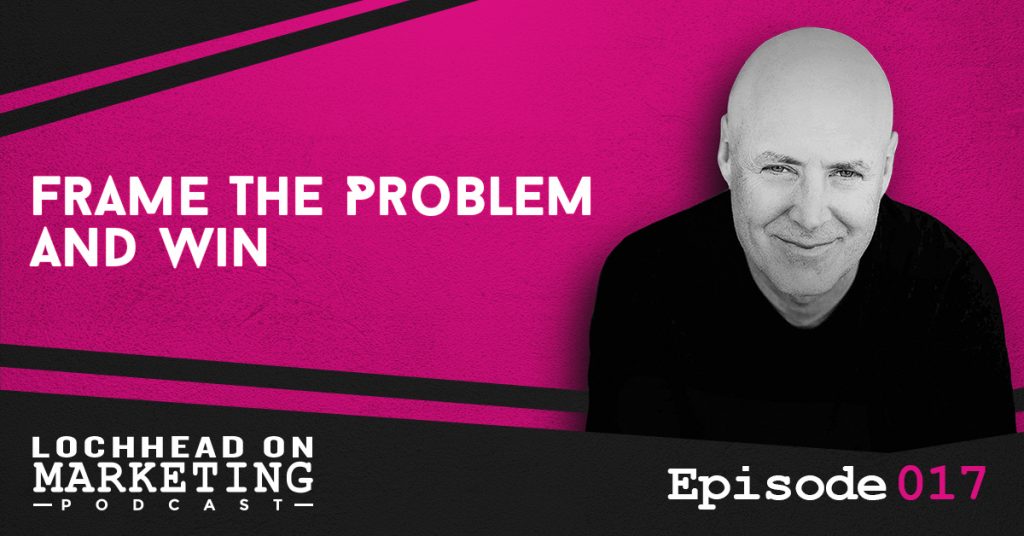
Podcast (lochheadonmarketing): Play in new window | Download (Duration: 10:52 — 10.0MB) | Embed
Subscribe: Apple Podcasts | Spotify | RSS | More
In this episode, Christopher Lochhead talks about why the company that frames and markets the problem, the most effectively, wins. To illustrate, he cites a music company, m, and ho they recently pulled something off in the marketing and PR point of view.
Frame the Problem, Not the Solution
Wise marketers and category creators have a strategic way of creating legendary marketing. One of these is framing the problem. This strategy is a sure-fire way to win a category.
“When the world agrees with you about the problem that you solved, and thinks about the problem, exactly the way you want them to, then they sort of have an ‘a-ha!’” – Christopher Lochhead.
Case In Point: Kobalt
One illustration of this point is a recent article about Kobalt. Kobalt is a music technology company, which recently raised $200 million in VC funding.
TechCrunch featured Kobalt in a two-part series. Christopher highlights a part of the article stating “changing the way the music industry does business and putting more money into musicians’ pockets in the process.”
What blew Christopher’s mind off is the title of the article: “How Kobalt is simplifying the killer complexities of the music industry.”
Why is this headline, mind-blowing?
Christopher believes that Kobalt’s PR team presented their company in a very effective way since TechCrunch featured them. The reporter Eric Peckam, needs to believe that there are “killer complexities” in the music business and that these need to be “simplified.”
“They [Kobalt] are evangelizing their problem and in this case, their getting the media to write a headline at the top of the homepage, with the exact framing of the problem that they want.” – Christopher Lochhead
As Christopher describes it, this is a legendary category design PR. Once people think that you get their problem, they connect the dots and infer that you have the solution.
“If you want to be moving your company forward, evangelize the problem. Spend a lot more time marketing, talking about the problem than the solution.” – Christopher Lochhead
To hear more about how to Frame the Problem and Win and more relevant information from Christopher Lochhead, download and listen to the episode.
Bio:
Christopher Lochhead is a Top 25 podcaster and #1 Amazon bestselling co-author of books: Niche Down and Play Bigger.
He has been an advisor to over 50 venture-backed startups; a former three-time Silicon Valley public company CMO and an entrepreneur.
Furthermore, he has been called “one of the best minds in marketing” by The Marketing Journal, a “Human Exclamation Point” by Fast Company, a “quasar” by NBA legend Bill Walton and “off-putting to some” by The Economist.
In addition, he served as a chief marketing officer of software juggernaut Mercury Interactive. Hewlett-Packard acquired the company in 2006, for $4.5 billion.
He also co-founded the marketing consulting firm LOCHHEAD; was the founding CMO of Internet consulting firm Scient, and served as head of marketing at the CRM software firm Vantive.
Links:
TechCrunch: How Kobalt is simplifying the killer complexities of the music industry
We hope you enjoyed this episode of Lochhead on Marketing™! Christopher loves hearing from his listeners. Feel free to email him, connect on Facebook, Twitter, Instagram and subscribe on iTunes!

